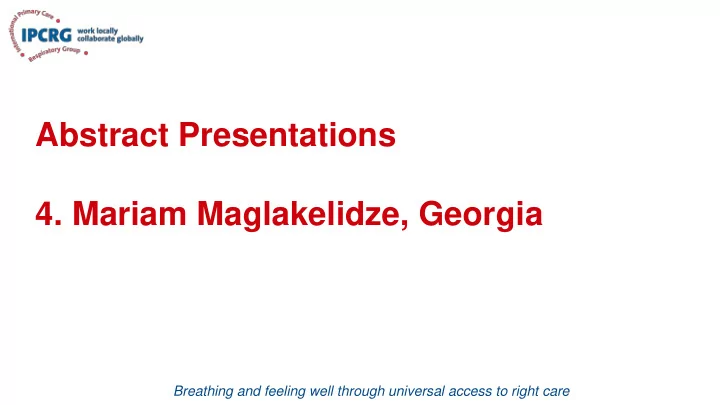

Abstract Presentations 4. Mariam Maglakelidze, Georgia Breathing and feeling well through universal access to right care
A randomized controlled feasibility trial (RCT) of a pulmonary rehabilitation (PR) programme for symptomatic COPD Patients in Georgia: A Breathe Well study Maglakelidze, N 1,3; Jolly, K 2 ; Maglakelidze, M 1 ; Maglakelidze, T 1 ; Chkhaidze, I 1 ; Dickens, A 2 ; Kurua, I 1 ; Gogvadze, K 1 ; Rai 2 , K; Enocson 2 , A; Adams, R 2 ; Jordan, R 2 ; ; Sitch, A 2 ; Turner, A 2 ; Adab, P 2 on behalf of the Breathe Well Group. Presenter: Mariam Maglakelidze Affiliations: 1 Georgian Respiratory Association, Georgia 2 Institute of Applied Health Research, University of Birmingham, Birmingham, UK 3 National Centre for Disease Control and Public Health, Georgia Breathing and feeling well through universal access to right care
Study methods • Aim : To assess the feasibility of delivering an RCT of a culturally tailored PR intervention in Tbilisi, Georgia. • Methods: An RCT with qualitative interviews. • Population: Symptomatic COPD patients, MRC ≥2, primary/secondary care • Intervention: Pulmonary rehabilitation, (pre rehab, PR twice a week. 8 week programme) • Control: 2 educational session after final follow-up at 6m • Outcome: o Feasibility: fidelity, acceptability, recruitment rate, follow-up rate at 6m, adherence, healthcare use, patient-incurred costs o Health outcomes: HRQOL, exercise capacity, smoking status, CAT, physical activity, anxiety/depression, exacerbations, healthcare use • Sample size: n=60 (30 per arm) • Research site: 1 hospital (Tbilisi)
Baseline characteristics, recruitment and follow-up Baseline Characteristics Usual Intervention Control Follow- Intervention All care (n=30) (n=30) up (n=30) (n=60) (n=30) Sex; n (%) male 26 (86.7) 28 (93.3) Age in years; mean (SD) 64 (7.3) 65 (8.7) 12 26 38 Employment; n (%) in work 7 (23.3) 13 (43.3) 8 weeks (40.0%) (86.7%) (63.3%) ISWT in metres; mean (SD) 229.7 (112.7) 249.3 (96.2) CAT; mean (SD) 20.3 (5.9) 19.9 (6.6) PHQ-9; mean (SD) 6.2 (4.02) 5.33 (4.06) 27 26 53 6 months (90.0%) (86.7%) (88.3%) Self-reported exacerbations 2.73 (0.94) 2.3 (1.14) in last 12m; median (IQR)
Attendance Intervention attendance % • 23 (77%) attended at 90 least once 80 • 13 (43%) attended at 70 60 least 70% of sessions 50 • Mean sessions attended: 40 30 7.8 (sd 6.7) 20 10 0 Pre 1 2 3 4 5 6 7 8 9 10 11 12 15 16
Secondary outcomes Baseline 8 week follow-up 6 month follow-up Intervention Usual care Intervention Usual care Intervention Usual care N=30 N=30 N=12 N=26 N=27 N=26 SGRQ – Impact (SD) 42.02 (19.9) 37.0 (20.3) 23.30 (25.6) 37.58 (23.2) 38.43 (23.6) 30.05 (20.0) SGRQ – Activity (SD) 67.03 (20.2) 56.92 (24.1) 42.45 (32.9) 58.60 (20.3) 58.48 (29.8) 49.20 (24.8) SGRQ – Symptoms (SD) 64.17 (17.1) 65.37 (15.0) 40.95 (31,56) 60.47 (25.7) 58.13 (23.4) 57.72 (24.8) SGRQ – Total (SD) 53.61 (17.2) 48.13 (17.9) 32.30 (27.4) 48.04 (20.8) 48.07 (23.5) 40.82 (20.0) ISWT (SD) 229.7 (112.7) 249.4 (96.2) 316.2 (134.3) 247.6 (113.5) 217.6 (89.6) 216.0 (99.4) CAT (SD) 20.3 (5.9) 19.93 (6.6) 13.76 (8,48) 18.32 (7.03) 17.85 (8.52) 17.65 (7.64) Stanford Self-Efficacy 5.71 (1.9) 6.66 (1.5) 7.76 (1.24) 6.9 (1.52) 6.96 (1.48) 7.28 (1.22) scale (SD) PHQ-9 (SD) 6.2 (4.0) 5.33 (4.1) 2.76 (1.92) 5.54 (5.09) 4.74 (4.24) 3.80 (3.02) GAD-7 (SD) 3.53 (3.2) 3.33 (2.8) 1.92 (1.60) 3.32 (3.47) 2.51 (3.28) 2.03 (2.06)
Qualitative Interviews Interviewed: 9 intervention participants and 2 rehabilitation specialists Acceptability: ➢ most had positive experience with the exercise, specialists, educational sessions and the booklet; education sessions and guidance by rehab specialists were highly valued Their experience of the PR programme: range of experiences ➢ Most were content with the PR, some felt the PR did not influence their condition much, and some emphasized that they felt more joyful: ▪ “ During these exercises I was noticing that I felt much better, my breathing was better, I felt more free. I did not have breathlessness” patient. ▪ “ Everything was positive. Whatever we were offered was very human and considerate for patients like us. Everything was consistent and acceptable. Despite weakness, I hope I will be able to exercise according to this program in summer” patient Barriers to continuing with the PR programme: ➢ Transport, weather, health condition, money, work related reasons
Conclusion: • A culturally adapted PR programme was feasible to deliver, acceptable for patients and PR specialists. • The rolling out of such programmes, free of charge, was strongly supported by intervention participants.
Acknowledgements Thank you This research was funded by the National Institute for Health Research (NIHR) NIHR global group on global COPD in primary care, University of Birmingham, (project reference: 16/137/95) using UK aid from the UK Government to support global health research. The views expressed in this presentation are those of the author(s) and not necessarily those of the NIHR or the UK Department of Health and Social Care.
Recommend
More recommend